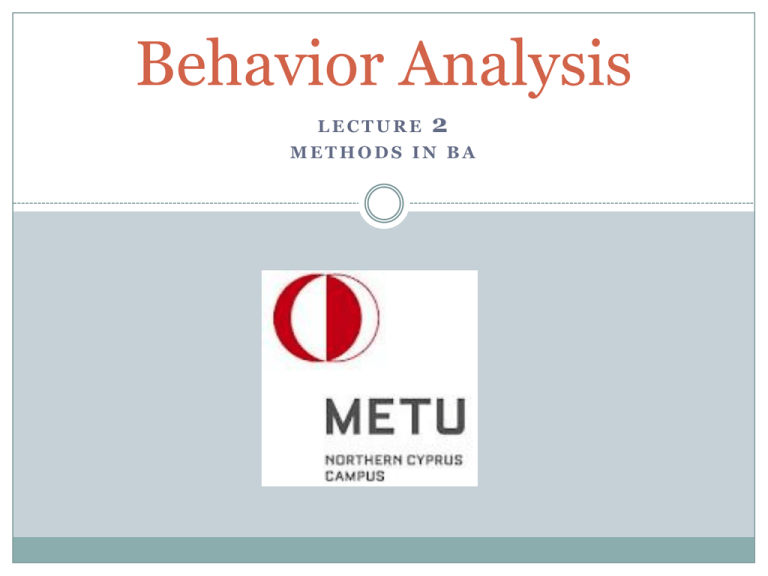lecture 2 - Nic Hooper, PhD
advertisement

Behavior Analysis LECTURE 2 METHODS IN BA Review What are the ABC’s of behavior analysis? Antecedents, behavior and consequences Why are the ABC’s important to us? Because behavior analysis is concerned with how antecedents and consequences (environmental events) are related to behavior What is applied behavior analysis Our attempts to solve behavior problems by altering the antecedents and consequences of behavior Before exploring interventions, its important we look at the methods used to attain information in behavior analysis Behavioral Assessment Problem solving, in all psychology, begins with an assessment of the problem. However behaviorists use a very specific technique called Behavioral Assessment. Behavioral Assessment: the attempt to (1) define the target behavior (2) identify functional relations between the target behavior and its antecedents and consequences; and (3) identify an effective intervention for changing the target behavior Let address each number! Defining the target behavior What is the target behavior? Target behavior: the behavior to be changed by an intervention Behavior Analysts are interested in changing the rate of behavior, the target behavior is normally the behavior that either needs to occur less, or it needs to occur more. Defining the target behavior The target behavior is usually defined in collaboration with the client. This can be done by interviewing the client, and sometimes those people close to the client Or client observations Sometimes questionnaires are used to achieve this end The point of this is to identify the actions that client does that are problematic Note: behavioral assessments target actual specific behavior, not fuzzy words like lazy, sarcastic, rude, unappreciative, insincere etc. It is often the case that most people don’t identify the actual behaviors that need to be changed Lets think of an example…. Defining the target behavior ‘My son Sid has anger problems, I want you to reduce my sons anger’ What is the target behavior here? Is anger a behavior? What does Sid do to make his father think he has anger issues Hits people Yells at his dad Throws his food on the floor Identifying the functional relations Once you know the target behavior, the next goal is to identify functional relations between the target behavior and its antecedents and consequences Again this can be done via interview Lets say that Sid’s problem is that he has a tendency to throw things, we need to know when this behavior occurs. The answer to this question need to be specific. There will be situations that Sid throws things, and there will be situations when Sid doesn't’t throw things, we need this information Identifying the functional relations Suppose Sid’s Dad describes a time in a grocery store when Sid began to throw things. We need to find out: Who was present? What time was it? Had anyone said anything to Sid? What happened when Sid began to scream? Did Dad shout at him? Did other people at the shop stare? Were they asked to leave? You need a detailed description about what happened before, during and after the target behavior Once you have learned of these antecedents and consequences, you need to ask the same set of questions about another episode Very soon you will have a pretty good idea about the antecedents and consequences that usually accompany the target behavior Identifying the functional relations Your interview notes will probably suggest some hypothesis about relation between the target behavior, its antecedents and consequences For example, you may have come to the conclusion that Sid’s tantrums happen when he is around food, and his request to have the food is denied. The tantrums are usually followed by Sid receiving the food he wanted. This is a reasonable hypothesis, but is it true? Identifying the functional relations In order to know this we have to conduct a functional analysis Functional analysis: the process of testing hypotheses about the functional relations among antecedents, target behavior and consequences A functional analysis begins with observations of the client, and whenever possible these are made in the natural environment, where the target behavior is a problem Identifying the functional relations In Sid’s case you might go to a grocery store and watch Sid and his Father If Sid throws things you note what happened before and after he started throwing things Did it begin when someone entered the area? When someone said something? When Dad suggested leaving? After throwing things, was he shouted at? Spanked? Given a toy? Identifying the functional relations When you have identified a functional relation between the target behavior, antecedents and consequences For example, you notice that Sid begins throwing things when he and his father reach the chocolate section, and that throwing things continues until his Father gives Sid chocolate Then you can test this relation! For example, you could have the Father go back to the chocolate area and see if the throwing begins Note: if its not possible to re-create the situation then you may manufacture one Identifying an intervention Once we know the target behavior, the antecedents and consequences, we can come up with tentative intervention plan We then discuss and test this plan with the client, and observe if we can reduce or increase the frequency of the target behavior How to observe and record events In order to conduct a behavioral assessment we have to do two things Observe events Record events. We now turn to some basic principles concerning the recording and analysis of behavior: Recording behavior rate Measuring the reliability of rate data Graphing behavior rates Evaluating the effects of an intervention Recording behavior rates Recording rate data means determining how many times a particular behavior occurs within a given period There are a number of informal and formal ways of doing this Informal ways of determining behavior rate One way is to simply ask the person who is engaging in the behavior However, people’s retrospective estimates are usually wrong e.g. if a particular behavior is unflattering then the person will create a biased estimate Giving people a survey may improve accuracy But you're still asking for a retrospective assessment And asking close friends of the clients will be equally inaccurate Because they too will have to rely on their memory and are still open to bias Formal ways on determining behavior rate As behaviorist, we cannot rely on hearsay when it comes to pinning down behavior rates with precision. We need someone to observe the behavior and tally the number of times it occurs within a given period There are two ways to count or record behavior; Continuous recording Interval recording Continuous recording Continuous recording: recording each and every occurrence of a target behavior within a given period As implied in the definition this involves observing a client and counting each time they exhibit the behavior We would do this for a pre arranged period of time, say half an hour to one hour There would usually be one or two observation periods for a number of days Continuous recording Why not follow people around all day? The person is unlikely to enjoy being followed around all day Also, as a behavior analyst were interested in problem behavior that occurs within a certain context, it would be a waste of time to be there all day when the behavior problem only occurs in certain situations In order to count behavior, analysts usually employ a tally sheet, which would include: Time and date of the observation period The locations where observations were made The name of the observer and the observations being made. A space for tally marks indicating the target behavior A notes section where other contextual notes are kept In the modern age, mechanical counters are often used Interval recording Some behaviors occur too frequently to be able to count accurately each occurrences over a certain time period For example, imagine measuring each time someone tapped their foot in a 30 minute period, if that person was prone to foot tapping! When behavior occurs at a high rate then we turn to interval recording Interval recording: recording whether a behavior occurs during each of a series of short intervals within an observation period Interval recording In interval recording, behavior is recorded during very small intervals, often less than 30 seconds, during an observation period In these periods we don’t count every time the behavior occurs, just if it occurs If it does the researcher makes a tally mark for that given time period Measuring the reliability of rate data Lets say I'm measuring the amount of times a student gets out of her seat without permission In order to do this, every 30 minutes, for 10 seconds I record whether she leaves her seat in that time What kind of recording is this? The data show that the student leaves her seat on 50% of the intervals How do we determine if that 50% figure is accurate? Inter observer reliability One way to do this is to have two people observe the same behavior If they come up with the same answer then we feel relatively confident that the answer is correct. In our research we call this Inter observe reliability: a measure of the degree of agreement in data tallies made by two or more observers There are several ways of calculating inter observer reliability Inter observer reliability Reliability of continuous data Observer 1 records that a behavior occurs 100 times in a half an hour period. Observer 2 records 150 times. In order to work out the inter observer reliability, we divide 100 by 150 and then multiply the answer by 100, giving us an inter observer reliability of 67. Reliability of interval data Count the number of intervals on which the two observers agree. Lets say 6 in this case Then you divide by the total number of intervals observed. Lets say 10. Then you multiply answer by 100 to get the inter observer reliability of 60. Most behaviorists would be happy with a reliability score of 90, anything below 80 would be seen as unreliable Improving reliability The major way in which we lessen the gap between two observers, or increase the reliability, is to precisely define the nature of the target behavior. For example, what would aggression look like in a classroom. This has to specific in order to people to record the behavior properly Once reliable data have been recorded then what does it mean, interpreting data is greatly facilitated by presenting it in graphical format Graphing behavior rates Students often hate graphs, mostly because of the link to Mathematics However, the point of graphs is to make difficult material easier to understand. In behavior analysis there are two types of graphs that we use to make formidable data as simple of possible Simple frequency graphs Cumulative frequency graphs Simple Frequency Graphs Simple frequency graph: a graph in which each data point indicates the number of times a behavior occurred a particular time Remember that the point of graphs is to help us see any trends in the data Lets say for example we were examining how many essays of a given subject that a student was completing over a 10 day period Simple Frequency Graphs 4 Essays 3 2 1 0 1 2 3 4 5 6 Days 7 8 9 10 Cumulative Frequency Graphs Cumulative frequency graph: a graph in which each data point indicates the total number of times the behavior has occurred up to that point While simple frequency graph shows the number of times a behavior occurs during a certain period A cumulative frequency graph shows the total number of times the behavior has occurred during that and all previous periods Note: if your cumulative frequency graph ever goes downwards, then you have done it wrong! Cumulative Frequency Graphs 25 Essays 20 15 10 5 0 1 2 3 4 5 6 Days 7 8 9 10 Evaluating the effects of an intervention The job of applied behavior analysts is to solve behavior problems i.e. increase or decrease the rate of behavior. But how can they be sure that the changes in behavior they get are due to their efforts? You all know that with group design studies we run statistical tests to see whether the differences between two groups of people are significantly different. However, group designs are not particularly helpful answering questions about the effects of experience on individual behavior. Single case experimental design Instead single case experimental designs are more appropriate Single case experimental design: a research design in which the behavior of an individual is compared under experimental and control conditions Here, we compare the performance of an individual under one condition, with that same individuals performance under other conditions. Instead of running statistical tests, we plot the data on a graph and examine it. Behavior analysts want effects of practical significance, not statistical significance Single case experimental design Now in order to test a particular variable on behavior, you must manipulate that variable while holding all other variables constant. In group research you do with by employing a control group In single case design, one way to do this is to use a baseline period Baseline: a period during which the behavior under study is recorded, but no attempt is made to modify it This data provides the basis for comparison. More psychologically, the baseline gives you a standard against which you can measure the effects of the IV Single case experimental design Once you have the baseline period, you can then introduce the IV Since now you are not only recording behavior, this stage of the experiment is now called the intervention period To determine the effect of the intervention, you compare performance during baseline with performance during intervention You do this by looking at the graphical representation of both periods Lets think of a example…. ABAB Reversal design How do we know that the difference found between baseline and intervention is because of our intervention Imagine that we gave math lessons by a booklet, subsequently we gave lessons on the computer. We aim to see which medium would produce more assignments being completed. The data looks as though the individual completes more assignments during the computer instructed lessons However what if the reason for the increase in lesson completion is because, as the student started the computer lessons, the students teacher threatened to tell his parents if he didn't’t improve in Math. This may have powered the results ABAB Reversal design One way to rule out this is by ABAB reversal design: a single case design in which baseline and intervention conditions are repeated with the same person. In ABAB design you essentially run the experiment twice to ensure that confounding variables didn’t power the results Example? Multiple baseline design ABAB design wouldn't’t work if you were solving a serious behavior problem, as you wouldn't’t want them to return to baseline just to check you're intervention worked For example, imagine some who was very violent In situations like this you need to replicate without returning to baseline Behaviorists do this using Multiple baseline design Multiple baseline design: a single case design in which the effects of an intervention are recorded across situations, behaviors, or individuals Multiple baseline design In multiple baseline experiments, as the name implies, there are multiple baseline periods As an example, think of Teddy, a four year old boy who has a problem with screaming loudly, in many different places, until people give in to his request. We want to see, if ignoring Teddy when he screams will reduce his screaming behavior. Of course, we cant employ ABAB design here as we don’t want him returning to baseline! Therefore we create multiple baselines; one in school, one at home, one in church etc. Then, once the baseline is stable in one place, the intervention is administered. This is then repeated for the other baselines The data may look something like this Multiple baseline design Multiple baseline design When looking at the data, you compare the behavior that occurs during the baseline and intervention across each situation If you get similar results across all situations then there is little doubt that the change is due to the intervention You can also have multiple baseline across different types of behavior For example, if teddy stamps his feet and hits people, then we could set up baselines for those behavior too, then measure the effect of the intervention You can also employ multiple baseline with different people presenting with a similar issue, to determine if your intervention worked Alternating treatment designs ‘But you're only using one intervention in these studies, what if you wanted to compare interventions? If you wanted to study the effects of different treatments then one way to do it could be to employ traditional group design experiments that you all have run However you could also employ an Alternating treatment design: a single case design in which two of more interventions alternate systematically Alternating treatment designs This design involves alternating the treatments in one client However, in order to rule out extraneous variables, it would be important to counterbalance the conditions within each client, and to run the study with a few different clients to see if the results are consistent Flash cards behavioral assessment define target behavior; 2 identify functional relations b/w behavior and antecedents/consequences; 3 identify effective intervention for changing target behavior target behavior behavior to be changed by an intervention functional analysis process of testing hypotheses about the functional relations among antecedents, target behavior, and consequences continuous recording recording each and every occurrence of a behavior during a prescribed period interval recording recording whether a behavior occurs during each of a series of short intervals within an observation period inter-observer reliability measure of the degree of agreement in data tallies made by two or more observers simple frequency graph graph in which each data point indicates the number of times a behavior occurred at a particular time Flash cards cumulative frequency graph graph in which each data point indicates the total number of time the behavior has occurred up to that point single-case experimental design research design in which behavior of an individual is compared under experimental and control conditions baseline period during which the behavior under study is recorded, but no attempt is made to modify it ABAB reversal design single case design in which baseline and intervention conditions are repeated with same person multiple baseline design single case design in which the effects of an intervention are recorded across situations, behaviors, or individuals alternating treatments design single case design in which two or more interventions alternate systematically








